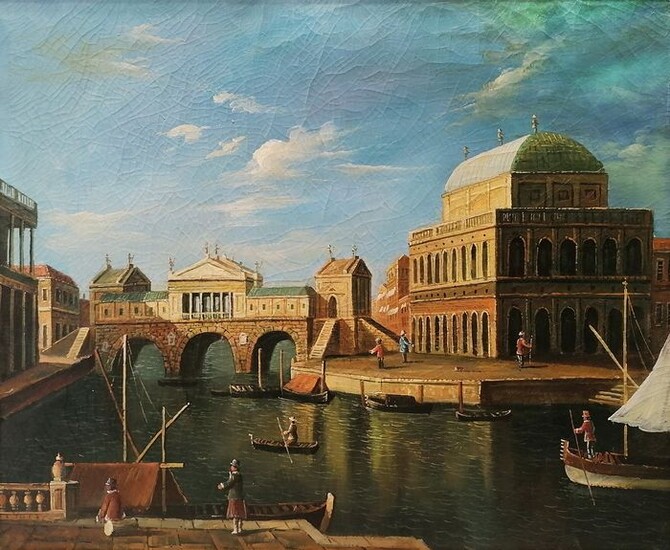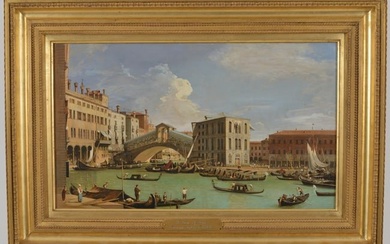Scuola Italiana (da Canaletto) - Capriccio con edifici palladiani
\Artist: Scuola Italiana (da Canaletto)
Technique: olio su lino, cm. 51,5 x 62\Signature: Not signed\Dimensions: 75_10_85_cm
Italian painter of the 20th century (Copy from Giovanni Antonio Canal, known as Canaletto) Capriccio, with buildings in Palladio style Oil on linen, cm 51. 5 x 62 cm - not signed Framed size: approx. 64 x 75 x 5 cm. Notes: Notes: The artwork is not signed. Certificate of lawful origin. Artwork comes with gilded and decorated frame: " . . . Beautiful painting in ancient style, oil on canvas, depicting a beautiful view featuring a Capriccio with Palladian buildings. In the 19th and 20th centuries some anonymous painters experimented with the art of "copying" the great masters of the past. One of them was Canaletto, although his photographic painting style remains unparalleled. The painter who created this work, of course, did not want to make use of his master's technique, but he managed to paint this famous view of Venice with talent, making us rediscover it during one of its beautiful lagoon dawns. The wonderful panoramic view of the scene was one of the most replicated and loved subjects by Antonio Canal, known as Canaletto (Venice, 1697-1768) during his long artistic career. The same view was later taken up by other skilled successors, up to this day. This image refers to the original Capriccio with Palladian buildings (oil on canvas, cm 58 x 82 cm) , made by Canaletto between about 1756-1759 and preserved in the Galleria Nazionale di Parma. The work was added to the collection of the Galleria Nazionale di Parma in 1825 after it was in the possession of the Duchess Marie Louise of Austria and prior to that of the Venetian family Aglietti. Many scholars have linked the subject to the famous letter sent in 1749 by Francesco Algarotti, Venetian writer and collector, to Prospero Pesci, Venetian painter, and considered by many a sort of "manifesto of the Capriccio". In the letter, Algarotti speaks of paintings that represent imaginary buildings or buildings that were extrapolated from other contexts, and an artwork is mentioned which can be identified as the Canaletto's Capriccio. Indeed, when this view is inspected, it unfolds the Grand Canal before the eyes of the observer, with a stream that seems faithfully borrowed from Canaletto’s view, crossed by a bridge. The gondolas and the boats tell us that we are in Venice, but the buildings, which actually exist, are in fact located in other cities. It is, indeed, a capriccio, a pictorial style that had great success in the eighteenth century. The Palladian Basilica is on the right and Palazzo Chiericati is on the left. They are both famous buildings of Vicenza, designed by Andrea Palladio. The centre features Palladio’s project for the Rialto Bridge, which was never realized (the project is located in a table of Chapter XIII, third book of “I quattro libri dell'architettura” by Andrea Palladio) . The canvas is a snapshot of daily life and, as in many other works of Canaletto, we can feel the air temperature, its degree of humidity, and the slight breeze that moves the air. These are all sensations that no modern photograph can reproduce. Those who look at a photograph know that it is a photograph, but those who look at a work by Canaletto such as this one and pause carefully, will have the feeling of perceiving reality concretely. The secret lies in painting with a free, simplified style that will then be reworked by the mind of the observer, generating an impression of truth. It is the same approach that Claude Monet will use over a century after Canaletto, with whom he shared the sense of light and the simplicity of the lines that represent it. It is therefore the brain that puts the image back together, because as we well know we do not see with the eyes but with the mind. And all this results in an image than is truer than a photograph. The painting offered here is characterized by a perspective approach identical to that of the museum version. The similarities, on the other hand, do not extend completely to the vessels, to the figures drawn and to the general chromatic affinity, also due to the difference in size. The view, characterised by a remarkable executive level, is attributable to a valid artist who observed Canaletto – active in the twentieth century – who was able to skilfully render the characteristics of the style and atmosphere of the view preserved in various museums. The canvas is in rather good overall condition of preservation, with the pictorial surface showing patina. There are no conservation issues and it does not seem to require restoration. The measurements of the canvas are: 52,5 x 62 cm. The painting, of good pictorial quality, comes with a handcrafted gilt wooden frame (dimensions cm about 64 x 75 x 5 Origin: private collection Publication: \t. Unpublished; \t. I Miti e il Territorio nella Sicilia dalle mille culture. INEDITA QUADRERIA general catalogue of the paintings from the collection of the series “I Miti e il Territorio”, publisher Lab_04, Marsala (being printed in 2022) . We also guarantee an accurate packaging with outer wooden crate and inner bubble wrap / cardboard / polystyrene (packaging cost: approximately €100. 00) and trackable shipping (€100. 00 to Italy) . For the export, the work is subject to a request for Certificate of Free Circulation (European Community) or Export Certificate (Extra-EU Transport) at the export office (Territorial Superintendency) with additional times and costs (€300/€500, all inclusive: shipping, packaging, and export documents) .
View it on
Estimate
Time, Location
Auction House
\Artist: Scuola Italiana (da Canaletto)
Technique: olio su lino, cm. 51,5 x 62\Signature: Not signed\Dimensions: 75_10_85_cm
Italian painter of the 20th century (Copy from Giovanni Antonio Canal, known as Canaletto) Capriccio, with buildings in Palladio style Oil on linen, cm 51. 5 x 62 cm - not signed Framed size: approx. 64 x 75 x 5 cm. Notes: Notes: The artwork is not signed. Certificate of lawful origin. Artwork comes with gilded and decorated frame: " . . . Beautiful painting in ancient style, oil on canvas, depicting a beautiful view featuring a Capriccio with Palladian buildings. In the 19th and 20th centuries some anonymous painters experimented with the art of "copying" the great masters of the past. One of them was Canaletto, although his photographic painting style remains unparalleled. The painter who created this work, of course, did not want to make use of his master's technique, but he managed to paint this famous view of Venice with talent, making us rediscover it during one of its beautiful lagoon dawns. The wonderful panoramic view of the scene was one of the most replicated and loved subjects by Antonio Canal, known as Canaletto (Venice, 1697-1768) during his long artistic career. The same view was later taken up by other skilled successors, up to this day. This image refers to the original Capriccio with Palladian buildings (oil on canvas, cm 58 x 82 cm) , made by Canaletto between about 1756-1759 and preserved in the Galleria Nazionale di Parma. The work was added to the collection of the Galleria Nazionale di Parma in 1825 after it was in the possession of the Duchess Marie Louise of Austria and prior to that of the Venetian family Aglietti. Many scholars have linked the subject to the famous letter sent in 1749 by Francesco Algarotti, Venetian writer and collector, to Prospero Pesci, Venetian painter, and considered by many a sort of "manifesto of the Capriccio". In the letter, Algarotti speaks of paintings that represent imaginary buildings or buildings that were extrapolated from other contexts, and an artwork is mentioned which can be identified as the Canaletto's Capriccio. Indeed, when this view is inspected, it unfolds the Grand Canal before the eyes of the observer, with a stream that seems faithfully borrowed from Canaletto’s view, crossed by a bridge. The gondolas and the boats tell us that we are in Venice, but the buildings, which actually exist, are in fact located in other cities. It is, indeed, a capriccio, a pictorial style that had great success in the eighteenth century. The Palladian Basilica is on the right and Palazzo Chiericati is on the left. They are both famous buildings of Vicenza, designed by Andrea Palladio. The centre features Palladio’s project for the Rialto Bridge, which was never realized (the project is located in a table of Chapter XIII, third book of “I quattro libri dell'architettura” by Andrea Palladio) . The canvas is a snapshot of daily life and, as in many other works of Canaletto, we can feel the air temperature, its degree of humidity, and the slight breeze that moves the air. These are all sensations that no modern photograph can reproduce. Those who look at a photograph know that it is a photograph, but those who look at a work by Canaletto such as this one and pause carefully, will have the feeling of perceiving reality concretely. The secret lies in painting with a free, simplified style that will then be reworked by the mind of the observer, generating an impression of truth. It is the same approach that Claude Monet will use over a century after Canaletto, with whom he shared the sense of light and the simplicity of the lines that represent it. It is therefore the brain that puts the image back together, because as we well know we do not see with the eyes but with the mind. And all this results in an image than is truer than a photograph. The painting offered here is characterized by a perspective approach identical to that of the museum version. The similarities, on the other hand, do not extend completely to the vessels, to the figures drawn and to the general chromatic affinity, also due to the difference in size. The view, characterised by a remarkable executive level, is attributable to a valid artist who observed Canaletto – active in the twentieth century – who was able to skilfully render the characteristics of the style and atmosphere of the view preserved in various museums. The canvas is in rather good overall condition of preservation, with the pictorial surface showing patina. There are no conservation issues and it does not seem to require restoration. The measurements of the canvas are: 52,5 x 62 cm. The painting, of good pictorial quality, comes with a handcrafted gilt wooden frame (dimensions cm about 64 x 75 x 5 Origin: private collection Publication: \t. Unpublished; \t. I Miti e il Territorio nella Sicilia dalle mille culture. INEDITA QUADRERIA general catalogue of the paintings from the collection of the series “I Miti e il Territorio”, publisher Lab_04, Marsala (being printed in 2022) . We also guarantee an accurate packaging with outer wooden crate and inner bubble wrap / cardboard / polystyrene (packaging cost: approximately €100. 00) and trackable shipping (€100. 00 to Italy) . For the export, the work is subject to a request for Certificate of Free Circulation (European Community) or Export Certificate (Extra-EU Transport) at the export office (Territorial Superintendency) with additional times and costs (€300/€500, all inclusive: shipping, packaging, and export documents) .




